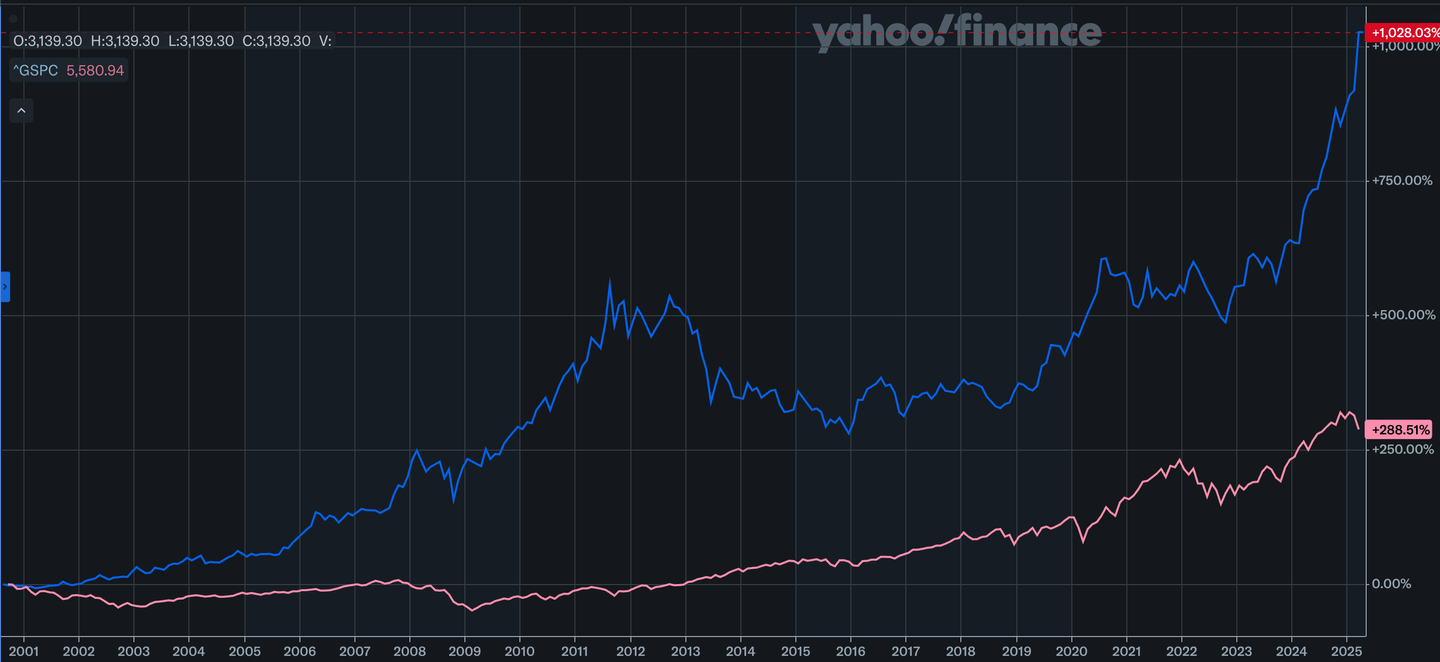Stock Market Outlook: April 2025
In this month's stock market outlook: How high might gold prices go in 2025? Plus: Bond investments that won't leave a big tax bill.

Many, or all, of the products featured on this page are from our advertising partners who compensate us when you take certain actions on our website or click to take an action on their website. However, this does not influence our evaluations. Our opinions are our own. Here is a list of our partners and here's how we make money.
The investing information provided on this page is for educational purposes only. NerdWallet, Inc. does not offer advisory or brokerage services, nor does it recommend or advise investors to buy or sell particular stocks, securities or other investments.
In this issue:
Investing in gold in 2025
We’re only three months into 2025, but it’s already shaping up to be a rough year for many investors. The S&P 500 index is down more than 4% for the year. Bitcoin is down more than 8%. Even many bond funds are flat for the year.
But gold has been a bright spot. The price of gold is up more than 15% so far this year. Here’s why, and what it means for investors.
What’s going on in the gold market this year?
Many of the largest investment banks, including J.P. Morgan, Goldman Sachs and Bank of America, have raised their gold price forecasts for 2025.
A mid-March note from J.P. Morgan forecasts a price as high as $3,200 per ounce by the end of the year. Goldman Sachs and Bank of America announced even more bullish gold outlooks last month, forecasting year-end prices of $3,300 and $3,350 per ounce, respectively.
All three banks cited global economic uncertainty related to the Trump administration’s tariff policies as a driver of demand for safe-haven assets such as gold.
J.P. Morgan and Goldman Sachs additionally expect the central banks of foreign countries to ramp up purchases of gold reserves due to the threat of sanctions, tariffs, and U.S. dollar volatility under the new administration.
Does gold belong in your portfolio?
Gold has outperformed the S&P 500 over the last 25 years, and some “lazy portfolios” (long-term-oriented model portfolios consisting of just a few index funds) recommend holding a small amount of gold for investment diversification purposes, such as the “Permanent Portfolio” popularized by investment advisor and author Harry Browne.
Proponents of gold investing sometimes claim that the metal’s price is uncorrelated to the stock market. But the chart below, which shows the price of gold futures in blue and the S&P 500 index in pink, casts some doubt on this idea.

Source: Yahoo Finance. Data is current as of Mar. 30, 2025, and intended for informational purposes only.
Gold’s investment performance does sometimes diverge from that of the S&P 500, especially during economic downturns such as the Great Recession or the COVID-19 pandemic in 2020, when gold rose in price rapidly in response to investor fear.
Gold has also languished for long periods in which the stock market was thriving, as it did for most of the 2010s. But for much of the period shown in the chart above, gold has moved in more or less the same direction as stocks.
Data from the World Gold Council show that the weekly returns of gold have had a low but positive correlation with the weekly returns of the S&P 500 index over the last 25 years, meaning that the two have moved in the same direction most of the time.
The implication is that gold isn’t necessarily a hedge against the stock market, despite its reputation of being precisely this. It’s more of a speculative investment.
In short, there are times, such as right now, when gold looks like a more appealing investment than stocks. Some investment strategists consider it a good way to diversify a portfolio, but the data suggests it’s not a golden ticket to riches.
What’s more, buying gold now means buying at new all-time highs. If you’re investing in gold for the long-term, that may not be a problem. But it’s something short-term traders should keep in mind.
» MORE: 4 ways to invest in gold in 2025
NerdWallet rating 4.8 /5 | NerdWallet rating 4.6 /5 | NerdWallet rating 4.5 /5 |
Fees $0 per online equity trade | Fees $0 | Fees $0 per trade |
Account minimum $0 | Account minimum $0 | Account minimum $0 |
Promotion None no promotion available at this time | Promotion Earn up to $10,000 when you transfer your investment portfolio to Public. | Promotion Get up to $700 when you open and fund a J.P. Morgan Self-Directed Investing account with qualifying new money. |
Term of the month: Tax-exempt bonds
Depending on how long you’ve waited to file, tax season is either over or in the home stretch. Regardless, if you had an investment-related tax bill to pay from 2024, you may be inspired to explore tax-exempt investments moving forward.
Below, we’re discussing a few types of bond investments whose interest payments are exempt from federal and/or state income tax, and are available in many brokerage accounts.
Note that the tax exemptions below only apply to the income you would receive by holding bonds to maturity. If you sell a bond before maturity, for a higher price than you paid for it, your profit may still be subject to capital gains tax.
» Need to reduce your tax bill now? You can still make tax-deductible IRA contributions for 2024 until Tax Day. Check out our list of the best IRA accounts if you want to open and fund one before the deadline.
Municipal bonds
States, cities, counties and other local governments sometimes issue municipal bonds, or “munis,” to fund public projects such as school and bridge construction.
Interest is exempt from: Federal income tax, and sometimes state income tax as well, depending on where you live and where the bond is from.Most states don’t tax their own muni bonds, and several have no state income tax at all. In those cases, muni bond interest is completely tax-free. District of Columbia residents also pay no local income taxes on any muni bonds, and all muni bonds from non-state U.S. territories such as Puerto Rico are state-tax-free in all states.In some cases, however, interest payments on muni bonds that fund business-like enterprises such as stadiums and airports may be subject to the alternative minimum tax (AMT).
Risk level: Medium.The yields on muni bonds are often higher than the yields on Treasury bonds. But that’s because, unlike the U.S. government, local governments do sometimes default on their debts. The city government of Detroit, for example, defaulted on more than $600 million worth of municipal bonds during its 2013 bankruptcy.
Some muni bonds also have “call risk” (the issuing government may repay the principal of the bond ahead of schedule, causing investors to miss out on some interest payments). Plus, due to their high yields, muni bond prices may fall sharply in response to an increase in interest rates. That’s not an issue if you hold the bonds you buy to maturity, but it’s something to keep in mind.
Available in: Certain brokerage accounts. Some accounts don’t offer individual bonds at all, and others only offer Treasury bonds and corporate bonds. Make sure you research a broker’s investment selections if you’re interested in buying individual muni bonds.
Below is a list of the brokers reviewed by NerdWallet that offer individual muni bonds:
Tax-exempt bond funds
Buying individual muni bonds can be a hassle. One way to simplify the process of adding muni bonds to your portfolio is by investing in a tax-exempt bond fund. These typically invest in muni bonds, and may be available as mutual funds or exchange-traded funds (ETFs).
There are even a few tax-exempt bond funds that invest in munis from a specific state, such as New York, thereby rendering their interest payments exempt from both federal and state taxes for residents of that state.
Interest is exempt from: Federal (and sometimes state) income tax… in theory. Some tax-exempt bond funds advertise themselves as “AMT-free” as well, meaning that they avoid muni bonds that may generate AMT liability.However, fund managers have a significant amount of discretion over what they invest in, and some tax-exempt bond funds disclaim that they may occasionally invest in assets that do have federal income tax or AMT liability. Make sure you read the fine print before investing.
Risk level: Medium-low.Funds containing muni bonds deal with the same risks as investors holding individual muni bonds, but a bond fund reduces these risks somewhat for its shareholders by diversifying its investments across many muni bonds.
Available in: Almost all brokerage accounts. Some brokerage accounts don’t offer mutual funds, but tax-exempt bond ETFs can be found wherever ETFs are sold (i.e., in just about any brokerage account).
Treasury bonds, bills and notes
The U.S. government borrows money by issuing Treasury securities of various durations. The term “Treasury bond” is sometimes used to refer specifically to bonds with durations of 20 years or more. Treasury securities with durations of 2 to 10 years are called “notes,” while shorter-duration securities are called “bills.”
Interest is exempt from: State income tax, but not federal income tax.
Risk level: Very low.The U.S. government is one of the most credible borrowers in the world. It’s not impossible that some cataclysm could cause it to miss payments on Treasuries at some point in the future, but that is so unlikely that it’s generally not worth worrying about.
In recent years, the U.S. government has sometimes had its credit rating downgraded by independent rating agencies, and there have been frequent political fights in Washington over keeping the government funded and raising the debt ceiling. But none of these things have led to a default yet, and the odds of one happening any time in the foreseeable future are still low.
Available in: Most brokerage accounts. Any account that offers individual bonds will offer Treasuries. There is also an emerging product called a Treasury account, which automatically invests — and re-invests — in T-bills. (NerdWallet has a partnership with Atomic Treasury to offer a Treasury account. Public, an online broker we review, also offers a Treasury account.)
» MORE: Best online brokers for bonds
Dates that could move markets this month
Economic events
Friday, Apr. 4: Bureau of Labor Statistics (BLS) monthly employment report. A report showing hiring levels and various measures of the unemployment rate.
Thursday, Apr. 10: BLS consumer price index (CPI) report. A key inflation gauge. The employment and CPI reports could give investors hints about what the Federal Reserve will do with interest rates in future meetings; unexpectedly high unemployment or low inflation could indicate that rate cuts are on the way.
Friday, Apr. 25: Michigan consumer survey data for April. The University of Michigan will release its preliminary data for this month’s survey on Apr. 11, and its final data on Apr. 25. The survey has become a closely watched indicator of ordinary Americans’ perceptions of the economy.
Wednesday, Apr. 30: Bureau of Economic Analysis first estimate of U.S. gross domestic product (GDP) in Q1 2025. A measurement of whether the economy grew or contracted over the quarter.
Earnings
Below is a table of blue-chip stocks that are reporting earnings in April, with the expected dates and average analyst estimates for their upcoming earnings reports.
We've filtered the list for companies with a market capitalization of at least $300 billion. These are high-volume stocks whose earnings reports are often major trading events for options traders and day traders.
Company name & symbol | Expected earnings date | Consensus EPS forecast |
|---|---|---|
J P Morgan Chase & Co (JPM) | Apr. 11, 2025 | $4.57 |
? | ? | ? |
? | ? | ? |
? | ? | ? |
? | ? | ? |
? | ? | ? |
? | ? | ? |
? | ? | ? |
? | ? | ? |
? | ? | ? |
? | ? | ? |
? | ? | ? |
? | ? | ? |
? | ? | ? |
? | ? | ? |
? | ? | ? |
? | ? | ? |
Source: Nasdaq.com. Data is current as of Mar. 30, 2025, and intended for informational purposes only.
» See our picks of the best day trading platforms.
More reading on gold, taxes and tech stocks
Neither the author nor editor owned positions in the aforementioned investments at the time of publication.





